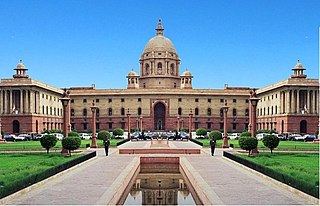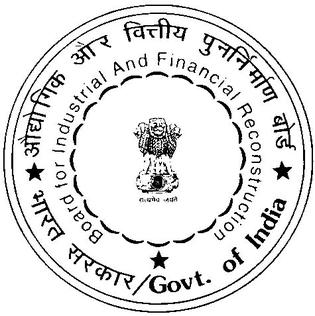
The Constitution of India is the supreme law of India. The document lays down the framework that demarcates fundamental political code, structure, procedures, powers, and duties of government institutions and sets out fundamental rights, directive principles, and the duties of citizens. It is the longest written national constitution in the world.

The economy of India is a middle income developing mixed economy. It is the world's sixth-largest economy by nominal GDP and the third-largest by purchasing power parity (PPP). According to the International Monetary Fund (IMF), on a per capita income basis, India ranked 145th by GDP (nominal) and 122th by GDP (PPP). From independence in 1947 until 1991, successive governments promoted protectionist economic policies, with extensive state intervention and economic regulation. This is characterised as dirigism, in the form of the License Raj. The end of the Cold War and an acute balance of payments crisis in 1991 led to the adoption of a broad economic liberalisation in India. Since the start of the 21st century, annual average GDP growth has been 6% to 7%, and from 2013 to 2018, India was the world's fastest growing major economy, surpassing China. Historically, India was the largest economy in the world for most of the two millennia from the 1st until the 19th century.
Modern banking in India originated in the mid of 18th century. Among the first banks were the Bank of Hindustan, which was established in 1770 and liquidated in 1829–32; and the General Bank of India, established in 1786 but failed in 1791.
The IDBI Bank Limited is an Indian private sector bank and a subsidiary of Life Insurance Corporation (LIC) providing financial and banking services. It was established in 1964 as Industrial Development Bank of India, a development finance institution, which provided financial services to industrial sector. In 2005, the institution was merged with its commercial division, IDBI Bank, forming the present-day banking entity and was categorised as "other public sector banks" category. Later in March 2019, RBI recategorised it as a private bank. Many national institutes find their roots in IDBI like SIDBI, India Exim Bank, National Stock Exchange of India and National Securities Depository Limited.

Kolkata is the prime business, commercial and financial hub of eastern India and the main port of communication for the North-East Indian states. Kolkata is the third largest economy in India after Mumbai and Delhi. Kolkata, with a GDP (PPP) of $60.447 billion is home to India's oldest, stock exchange company (bourse) – The Calcutta Stock Exchange. Kolkata is home to many industrial units operated by large public- and private-sector corporations; major sectors include steel, heavy engineering, mining, minerals, cement, pharmaceuticals, food processing, agriculture, electronics, textiles, and jute.
Life insurance is one of the fastest-growing sectors in India since 2000 as Government allowed Private players and FDI up to 26% and recently Cabinet approved a proposal to increase it to 49%. In 1955, mean risk per policy of Indian and foreign life insurers amounted respectively to ₹2,950 & ₹7,859. Life Insurance in India was nationalised by incorporating Life Insurance Corporation (LIC) in 1956. All private life insurance companies at that time were taken over by LIC. In 1993, the Government of India appointed RN Malhotra Committee to lay down a road map for privatisation of the life insurance sector.
Insurance in India refers to the market for insurance in India which covers both the public and private sector organisations. It is listed in the Constitution of India in the Seventh Schedule as a Union List subject, meaning it can only be legislated by the Central Government only.
Jiban Bima Corporation (JBC) is the state-run life insurance corporation in Bangladesh under the provisions of the Insurance Act 1938, Insurance Rules 1958, and related other laws enforceable in Bangladesh in Bangladesh Corporation Act 1973. The JBC started on 14 May 1973 with assets and liabilities worth TK. 157 million of defunct 37 life Insurance companies.
Insurance law is the practice of law surrounding insurance, including insurance policies and claims. It can be broadly broken into three categories - regulation of the business of insurance; regulation of the content of insurance policies, especially with regard to consumer policies; and regulation of claim handling wise.

The Ministry of Finance is a ministry within the Government of India concerned with the economy of India, serving as the Indian Treasury Department. In particular, it concerns itself with taxation, financial legislation, financial institutions, capital markets, centre and state finances, and the Union Budget.

Indian labour law refers to law regulating labour in India. Traditionally, Indian government at the federal and state levels have sought to ensure a high degree of protection for workers, but in practice, this differs due to form of government and because labour is a subject in the concurrent list of the Indian Constitution. The Minimum Wages Act 1948 requires companies to pay the minimum wage set by the government alongside limiting working weeks to 40 hours. Overtime is strongly discouraged with the premium on overtime being 100% of the total wage. The Payment of Wages Act 1936 mandates the payment of wages on time on the last working day of every month. The Factories Act 1948 and the Shops and Establishment Act 1960 mandates 15 working days of fully paid vacation leaves each year to each employee with an addition 10 fully paid sick days. The Maternity Benefit (Amendment) Act, 2017 gives female employees of every company the right to take 6 months worth of fully paid maternity leave. It also provides for 6 weeks worth of paid leaves in case of miscarriage or medical termination of pregnancy. The Employees' Provident Fund Organisation and the Employees' State Insurance, governed by statutory acts provides for retirement benefits and medical and unemployment benefits respectively. Workers entitled to be covered under the Employees' State Insurance are also entitled 90 days worth of paid medical leaves. A contract of employment can always provide for more rights than the statutory minimum set rights. The Indian parliament passed four labour codes in 2019 and 2020 sessions. These four codes will consolidate 44 existing labour laws. They are: The Industrial Relations Code 2020, The Code on Social Security 2020, The Occupational Safety, Health and Working Conditions Code, 2020 and The Code on Wages 2019.

National Insurance Company Limited (NICL) is an Indian nationalised general insurance company. It is under the ownership of Ministry of Finance, Government of India. Its catchline is "Trusted Since 1906" in italic. The company headquartered at Kolkata was established in 1906 by Gordhandas Dutia and Jeevan Das Dutia and National Insurance company and Asian Insurance company was nationalised in 1972. Its portfolio consists of a multitude of general insurance policies, offered to a wide arena of clients encompassing different sectors of the economy. Apart from being a leading insurance provider in India, NICL also serves Nepal.

The Board for Industrial and Financial Reconstruction (BIFR) was an agency of the Government of India, part of the Department of Financial Services of the Ministry of Finance. Set up in January 1987 by the Rajiv Gandhi government, its objective was to determine sickness of industrial companies and to assist in reviving those that may be viable and shutting down the others. On 1 December 2016, the Narendra Modi government dissolved BIFR and referred all proceedings to the National Company Law Tribunal (NCLT) and National Company Law Appellate Tribunal (NCLAT) as per provisions of Insolvency and Bankruptcy Code.

The Insurance Regulatory and Development Authority of India (IRDAI) is a regulatory body under the jurisdiction of Ministry of Finance, Government of India and is tasked with regulating and licensing the insurance and re-insurance industries in India. It was constituted by the Insurance Regulatory and Development Authority Act, 1999, an Act of Parliament passed by the Government of India. The agency's headquarters are in Hyderabad, Telangana, where it moved from Delhi in 2001.

The Companies Act 2013 is an Act of the Parliament of India on Indian company law which regulates incorporation of a company, responsibilities of a company, directors, dissolution of a company. The 2013 Act is divided into 29 chapters containing 470 sections as against 658 Sections in the Companies Act, 1956 and has 7 schedules. However, currently there are only 438 (470-39+7) sections remains in this Act. The Act has replaced The Companies Act, 1956 after receiving the assent of the President of India on 29 August 2013.The section 1 of the companies Act 2013 came into force on 30 August 2013. 98 different sections of the companies Act came into force on 12 September 2013 with few changes like earlier private companies maximum number of members were 50 and now it will be 200. A new term of "one-person company" is included in this act that will be a private company and with only 98 sections of the Act notified. A total of another 183 sections came into force from 1 April 2014.

Indian company law regulates corporations formed under Section 2(20) of the Indian Companies Act of 2013, superseding the Companies Act of 1956.
A government-owned enterprise, a government-owned corporation, a statutory corporation or a nationalized company in India is called a Public Sector Undertaking (PSU) or a Public Sector Enterprise (PSE). These establishments are wholly or partly owned by the government of India and/or one of the many state or territorial governments. The employees of these PSEs—Gazetted officers and their subordinates—are fully-fledged government employees. Central Public Sector Undertakings are wholly or partly owned by the government of India, while State Level Public Sector Undertakings are wholly or partly owned by state or territorial governments.

The Motor Vehicles Act is an Act of the Parliament of India which regulates all aspects of road transport vehicles. The Act provides in detail the legislative provisions regarding licensing of drivers/conductors, registration of motor vehicles, control of motor vehicles through permits, special provisions relating to state transport undertakings, traffic regulation, insurance, liability, offences and penalties, etc. For exercising the legislative provisions of the Act, the Government of India made the Central Motor Vehicles Rules 1989.










